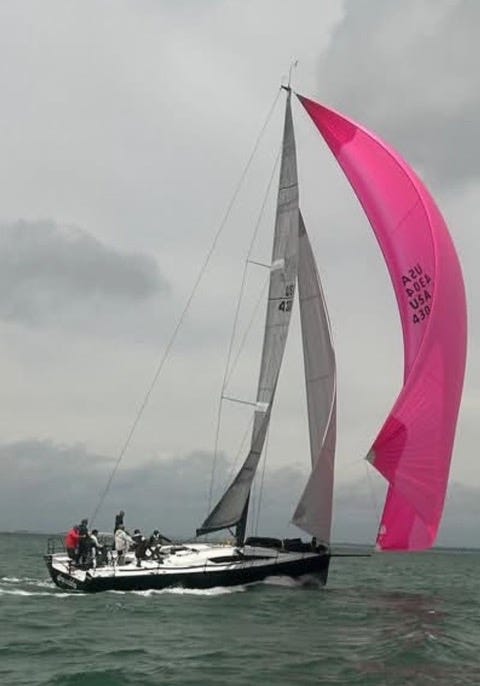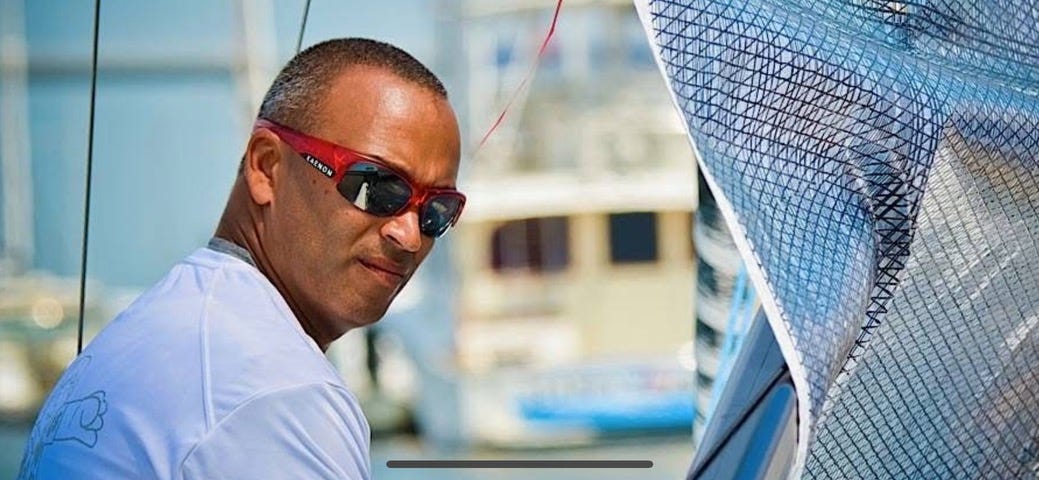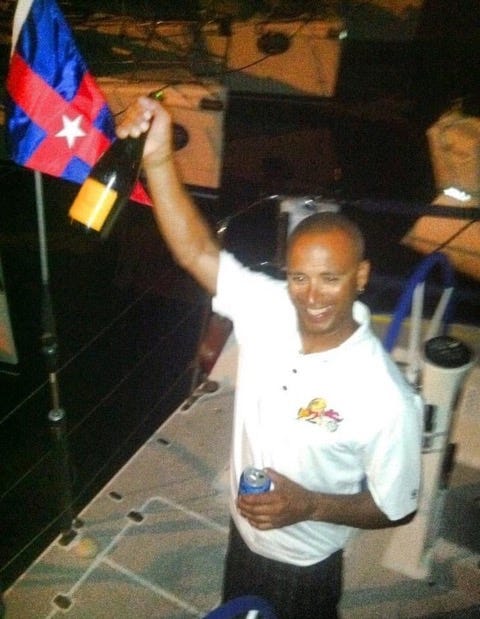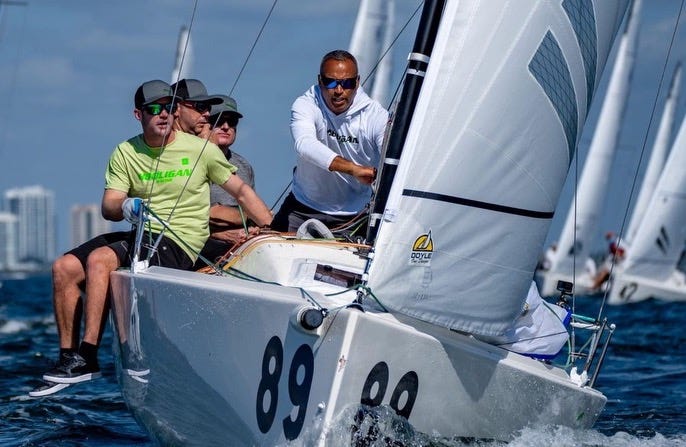World champion who races Mackinac: Mistakes to avoid
Curtis Florence, known for his skill in changing sails, finds victory in tiny details
Curtis Florence is 56 but he stopped counting at 49.
“I’m young at heart,” he said, laughing.
His athleticism has led to a global reputation for brilliant sailing and an impressive career as a professional sailor that included being named Rolex Sailor of the Year by the Canadian Yachting Association — and winning multiple world championships.
When I asked competitive racers in different states who’s considered the best on the bow — the person on the front of the boat who gets sails up and down with speed — the name Curtis Florence surfaced again and again.
No, he doesn’t live in Annapolis, Maryland or Newport Beach, California.
Florence lives in Cleveland, Ohio. He belongs to Edgewater Yacht Club overlooking Lake Erie.
On multiple days this week, he’s racing in preparation for the Admiral’s Cup, organized by the Royal Ocean Racing Club from Cowes, Island of Wight, off the coast of England.
I asked if he would share tips as we head into peak sailing season on the Great Lakes. Despite having a five hour time difference and juggling races, Florence agreed without hesitation.
Florence, a native of Kingsville, Ontario, Canada, will compete in the elite two-week competition that begins July 17 racing Abracadabra, a Ker 43 sailboat based in Holland, Mich.

Next month, Florence will race on Hooligan, a TP52 sailboat owned by John Evans and Trey Sheehan based in Cleveland, Ohio, in the 101st Bayview Mackinac Race from Port Huron to Mackinac Island.
After sailing 259 nautical miles (298 statute miles) to Mackinac Island, Hooligan will continue racing to the Chicago Yacht Club as part of the Ultra Mac race, which is 548 nautical miles (631 statute miles) total.
After racing on Sheehan’s team for years, Florence went to work 11 years ago for Sheehan, managing the building in downtown Cleveland that houses his business operations.
“He allows me to have time off my real job to go sailing now,” Florence said.

“Being at the age I am, there are obviously younger and stronger and faster guys doing what I used to do on the bow. But I can anticipate what needs to happen,” Florence said. “With me in the pit, I’m the one controlling all the strings — or lines — that the bow people need. I can anticipate what they need. I can offer guidance on how things should happen.”
Remember: Things need to happen really smoothly. Having somebody with experience and knowledge of what goes on up on the bow is key.
1. Teamwork matters
Understand how the sailor on a bow sees their role. It’s critical.
“The bow for me is personal where the foredeck is more of a team,” Florence said. “It takes both to make things happen. It’s not the bow guy on a boat that ever makes anything happen. It’s the foredeck team. At end of day, it’s how the bow guy manages the foredeck team.”
“When you get somebody standing up there, saying, ‘I do bow,’ well, ok, fine, whatever. You want somebody who says, ‘I do foredeck and my team is involved.’ They know it’s never themselves. Well, maybe on a 20-foot or 25-foot boat, it’s just the bow guy because that’s a lot less space. But on the bigger boats, the Mackinac boats, it’s the foredeck team.”
2. Be open to advice, always
Stop talking. Listen.
“In a Mackinac race, of the many things age and experience have taught me, is that if you’re not willing to listen or take advice, those are the things that will hurt you in the long run,” Florence said.
“When a bow person will stand up at the bow and say, ‘I want this or I want that,’ and somebody behind them will be, like, ‘Maybe we should do it this way,’ listening is important. But somebody does need to be in charge. For things that have to happen on the front end, that is the bow guy. He (or she) has to have the experience to know what they’re talking about,” he said.
3. Slow down and be precise
Just breathe. When you feel the need to speed up, slow down.
“Common mistakes are caused by trying to rush things,” Florence said. “You have to methodically think about how things are happening. When you try to get things done fast, but not think about how to do them correctly, that’s a mistake.”
Inexperience creates problems. Confidence is essential. Feeling unsure is a problem.
“This event here, I have a great bow guy but he’s second-guessing himself on all his decisions,” Florence said. “I need to remind him and say, ‘You’re good enough. You know stuff. You know what you’re talking about, just do it. You come by this naturally, you know how it goes. Just do it.”
4. Create contingency plans constantly
To win Mackinac races, sailors must think through different scenarios in their minds at all times. That means Plan A, Plan B and even Plan C.
“You can have a lot of different weather conditions happen upon you really fast,” Florence said. “Now the race goes from 5 to 10 knots race to — everybody knows on the Great Lakes how it can pick up to 25 knots in no time flat. You have to think about safety and the team and what they’re doing and act accordingly.”
This is where things get dicey in racing.
“I think I’ve made a lot of mistakes just because of not knowing what the next step is supposed to be,” Florence said. “What that has taught me is to not only think about what’s going on on our boat in front of me, but think about what my next step is.”
“When I want to run through a scenario on the boat, I usually go through three scenarios.”
If a boat is going around the mark on a racecourse, or changing the spinnaker — the large sail used when the wind is pushing from behind — things are going to happen.
“I sit there and explain to my bow team, if this doesn’t work the way it’s supposed to — this is our Plan B,” Florence said. “It’s an open conversation between the bow team on what’s going to happen next or what could possibly happen. In my life of sailing, you always always come up with Plan A and Plan B and, if stuff is really going crazy, a Plan C. This way, everybody is on the same page about what’s going on in the boat. What’s happening.”
When the time comes, Florence will just yell “Plan B.” It’s that simple.
“The more knowledge people have around you, the better off you are,” he said. “The biggest problem in our sport is when you see a guy with a pole in the air wiping out because they didn’t have a plan and didn’t know what was going to happen.”
When everyone clearly understands their job and does it well, the boat wins.
“If I’m talking to the bow team, I’m talking quietly within my own team. You’re trying to keep your voice down. If I’m talking about the overall picture, I might be louder,” Florence said. “At end of day, the guys at the back of boat have a tough enough job as it is. They don’t need to hear how we’re going to take a spinnaker down … When the back of the boat tells me we need to do a change — I just need to hear, ‘We’re changing.’ How we do it should be up to the front of the boat. I think it’s a trust issue. The people in the back need to trust the front of the boat on how to do their jobs.”
5. Practice like an Olympian
Before every Mackinac Race, the team should do test runs.
“Our boat captain makes sure the boat is perfect. The tactician looks at the race details. Our navigator works on the forecast and possible scenarios we could be facing. We practice all different sail changes,” Florence said. “We’ll go out in Chicago with the whole team before the event. We’ll track weather, we’ll do a first start and run scenarios. It’s really helpful.”
Top teams assign specific roles to all sailors and sailors take on those roles with discipline before the race start.
“You prepare yourself,” Florence said.
Big boats can finish the Mackinac in 24-30 hours so it’s not forced to stagger sleep schedules with a watch system like smaller boats.
6. Take snacks, resist alcohol (until later)
Hot coffee keeps sailors on Hooligan going. Power bars, beef jerky and freeze dried foods are popular. Their classic “candy salad” — a bag that looks like something a 10-year-old takes home at the end of Halloween night — is devoured by the sailors on the rail almost immediately.
I cannot believe a coffee company doesn’t sponsor the Mackinac Race. Or licorice. Or protein bars. It’s 200 boats filled with sailors loyal to your product for years. (Ask old sailors about why they drink Tito’s Vodka or Bell’s Beer or Bacardi Rum.)
In the end, get rest and don’t go drinking at the bar the night before the race. That’s not serious and it can be really insulting to crew working hard to win.
“Understand the weather conditions, what you’re getting into and push and race as hard as you can,” Florence said.
Every single second matters
Nothing is more challenging than pushing hard on the racecourse when no other boat’s in sight. But it’s critical.
“That’s the hardest thing about Mackinac. You don’t have someone around you all the time,” Florence said. “You need to put your foot on the gas pedal and keep going and push and push and push. Every second matters.”
There’s no worse feeling in the world than losing a big race by seconds.
“Nothing is worse than losing by 30 seconds,” Florence said. “You can think of probably 50 or 100 scenarios in that race where you could have made up 30 seconds.”
Maybe people just racing with friends or family don’t want to push hard but sailors need to know there is no better feeling than winning overall at Mackinac. Currently, 195 boats are registered to race from Port Huron to Mackinac.
“Winning your class is phenomenal but winning that race overall, nobody can take that from you,” Florence said. “The Mackinac Race, whether Chicago or Port Huron, is known worldwide.”
What’s next
After sailing in Admiral’s Cup pre-events, Florence said the team is doing well but can do better. The boat arrived later than expected, which cut into practice time.
Florence flies home to the U.S. on June 30th to do the Ultra Mac, from Port Huron to Chicago. Then he flies back to Europe on Tuesday, July 15 to do the Admiral’s Cup that starts 48 hours later.

This article part of an annual summer series on sailboat racing. Find all sailor stories here.
Sailor beats death under moonless sky
Fast Tango: ‘Dead f**king last' to victory after big mistake in 100th Mackinac race
Mackinac Fire Chief throws pickle party after epic loss
Note: I’m a proud member of the Iowa Writers’ Collaborative. This week, I recommend Stray Thoughts by Randy Evans titled, “Our founders would be cheering” about American history.








P W H
Good stuff, again. Curtis must be a very knowledgeable sailor, as he has a distinct working knowledge of the game. Thanks for the timely story, considering in less than one month those brave, enterprising sailors will once again try to master the Great Lakes from two angles, that being from Port Huron, and Chicago to our beautiful Mackinac Island. Let’s pray they all make it, sooner than later, and all healthy. Those sailors are inspirational, and goal oriented .
Thanks for your work, Ms Howard.
Gregg
PEACE
These aren't just sailing lessons. They are life lessons!